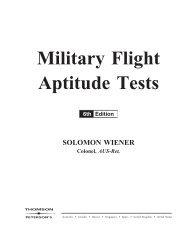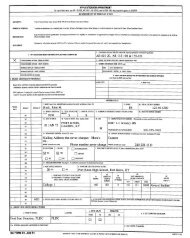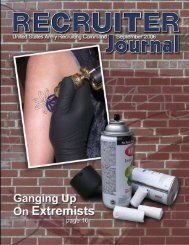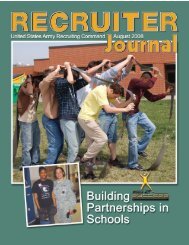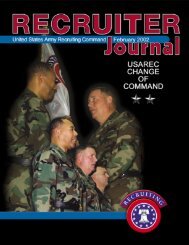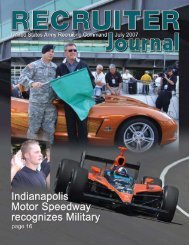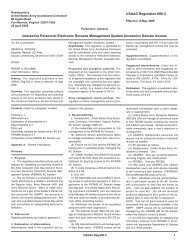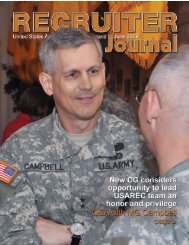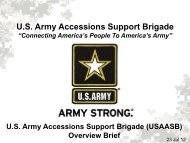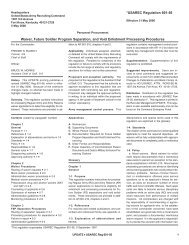19 Dec Cover.pmd - USAREC - U.S. Army
19 Dec Cover.pmd - USAREC - U.S. Army
19 Dec Cover.pmd - USAREC - U.S. Army
Create successful ePaper yourself
Turn your PDF publications into a flip-book with our unique Google optimized e-Paper software.
is necessary to read a civilian witness their rights (or whether you possess the authority to do so), call the BJA or<br />
legal advisor for guidance.<br />
(4) <strong>USAREC</strong> Form 722, Privacy Act Statement (figure 2) will be provided to a witness if the report will be filed<br />
in a system of records from which it can be retrieved by reference to the name, social security number, or other<br />
such personal identifier of the witness. This will normally include the subject(s) of the investigation, including<br />
applicants in recruiting impropriety investigations and victims in investigations of alleged misconduct. If in doubt<br />
as to whether the advisement should be provided, consult your BJA or legal advisor.<br />
(5) Good interviews tend to have distinct phases.<br />
(a) Phase I: Introduction and rights advisements, as appropriate.<br />
(b) Phase II: Develop a narrative. Let the person tell their version of events orally. Ask questions to clarify but<br />
not to narrow the discussion.<br />
(c) Phase III: Commit the narrative to writing. Have the interviewee write down their version of events in detail.<br />
(d) Phase IV: Use a question and answer (Q&A) format to clarify and refine the witness’s statement.<br />
(6) All statements will be sworn, if possible. Except in unusual circumstances DA Form 2823 (Sworn Statement)<br />
will be used. Most IOs find it helpful to have a general discussion with the witness first, then ask specific questions.<br />
During the interview the IO should take notes or use a tape recorder, but use of a tape recorder is not encouraged. If<br />
the conversation is recorded, you must notify the witness of your intention at the beginning of the tape. If you are<br />
taping a telephonic conversation, you must obtain the other person’s consent. The statements should be typed so<br />
they can be easily read; if typed statements are not possible, have the witness print legibly. Avoid the temptation to<br />
make the written statements overly short after an extensive interview. Witness statements that are appended to the<br />
ROI must support the substance of your report. Generally oral testimony of a witness may not be used in your<br />
report unless the content has been reduced to writing. If you must consider oral testimony in reaching your findings<br />
and recommendations, you must reduce the oral testimony to writing—in the format of a memorandum for record<br />
or record of conversation. It is best to have the individual review what you have prepared and sign the document<br />
once they have verified it is an accurate reflection of their statement. Include the memorandum with the report as<br />
a substitute for a sworn statement.<br />
(7) If one witness contradicts another witness, get each witness to fully clarify their statements. This may require<br />
reinterviewing the earlier witness. This ensures that witnesses have an opportunity to explain contradictory statements.<br />
(8) Some things to do when interviewing witnesses:<br />
(a) Take charge of the interview.<br />
(b) Get the witness to explain thoroughly and be specific. For example, if the witness says “someone at the<br />
recruiting station told me X; ask the witness who told them X (that is, get a name or description of the person).<br />
(c) Develop the facts completely; do not leave questions unanswered.<br />
(d) Honor the rights of witnesses.<br />
(e) Be fair.<br />
(f) Be professional.<br />
(g) Consciously consider your demeanor during the interview because you represent the <strong>Army</strong>.<br />
(h) Be objective and discreet. Because you are required to be fair and unbiased, do not presume the guilt or<br />
innocence of any party before completing the investigation. For example, when a recruiter is accused of providing<br />
a ringer for testing, look for evidence to establish that a ringer was used and who (applicant or recruiter) was<br />
responsible for obtaining the services of the ringer.<br />
(i) Give the witness an opportunity to think.<br />
(j) Check for loose ends. Try to do this before concluding each interview. Check your preparatory notes for the<br />
information you expected to gain from the witness and ensure you’ve exhausted their knowledge of these facts.<br />
(k) Instruct the witness not to speak with other witnesses. Ensure witnesses are aware that it could be a violation<br />
of <strong>USAREC</strong> Reg 601-45 to speak to other witnesses about the subject matter being investigated before the<br />
investigation has been completed.<br />
(l) Be thorough. Ensure witnesses explain ambiguous terms such as “affair” or “relationship.” Focus on collecting<br />
the facts. Ask what conduct the witness observed and how that conduct led them to believe the “affair” or “relationship”<br />
happened.<br />
(m) Ask witnesses if they know anyone else who should be interviewed or can confirm what they have just told<br />
you.<br />
(n) If during an interview you refer to a document/exhibit, such as to determine if the witnesses recognizes it,<br />
identify the document in the witness statement and make sure the document is attached as an exhibit to the ROI.<br />
<strong>USAREC</strong> Pam 27-65 • 20 <strong>Dec</strong>ember 2012<br />
3



